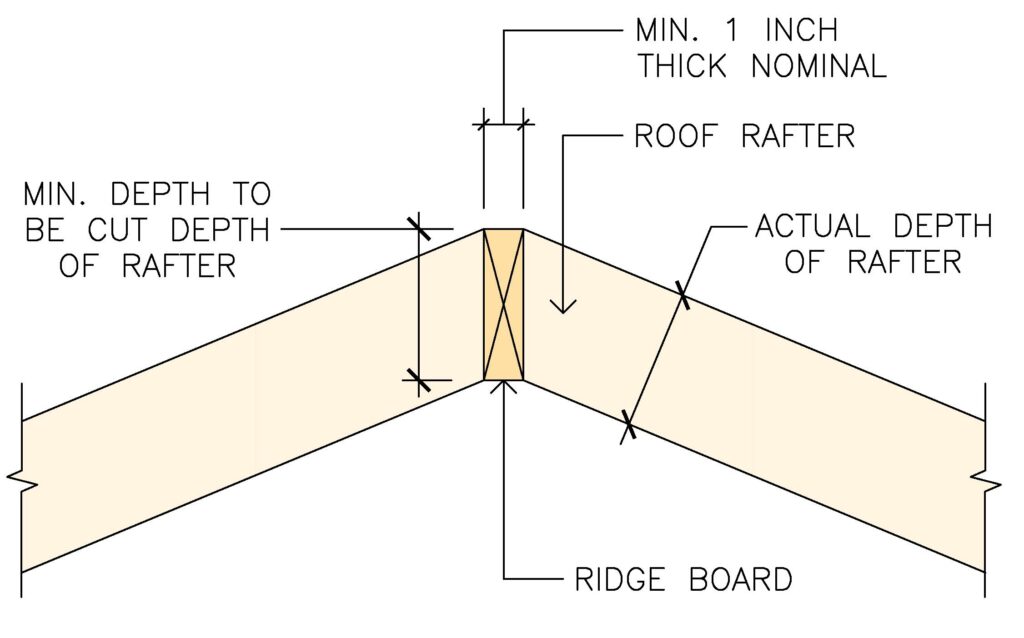Ridge board requirements for residential structures can be found in Section R802.3 of the 2018 International Residential Code. This section will outline what size a ridge board needs to be and what purpose it serves.
When is a Ridge Beam Required?
The International Residential Code covers the prescriptive requirements for roof framing. The prescriptive requirements include the use of a ridge board to connect the rafters at the ridge. When a ridge board is used, the roof assembly requires continuous ties across the structure to be installed to prevent roof thrust from being applied to the walls that the rafters rest on.
These ties can be the ceiling joists themselves, or if no ceiling joists are provided, rafter ties must be installed. When the roof assembly is not tied together by continuous ties at the end of the rafters, a ridge beam is then required.
A ridge beam does not fall into the prescriptive requirements of the code. When a ridge beam is required, it must be designed by an engineer to carry the roof loads.
The rafters, ties, and ridge board act somewhat like a truss but when the ties are removed, the ridge board cannot carry the roof load alone since it is not considered a structural load-bearing member. With no ties provided across the structure, the rafter thrust from the roof assembly can displace the supporting walls that the roof system rests on.
This is why a ridge beam would be required, to carry the roof loads and not displace the walls. Again a ridge beam must be designed by an engineer to ensure the size of it is adequate to support the loads it will carry.
Ridge Board vs. Ridge Beam
A lot of times a ridge board gets confused with a ridge beam, therefore it is very important to understand the difference between these two as they may sound similar but yet are very different in the purpose they serve.
Typically a ridge board is provided between rafters at the top of the roof system as a nailing base to connect opposing rafters and to provide a framing member that the rafters can rest on.
As for a ridge beam, it is designed to carry roof loads that include the roof weight plus any live load such as rain or snow. The ridge beam must also be strong enough to resist the loads placed by the rafters it carries to minimize deflection.
What is the Minimum Size of a Ridge Board?
When a ridge board is used, Section R802.3 requires the ridge board to not be less than 1 inch thick nominal and to have a depth that is not less than the cut end of the rafter it serves.
The graphic below provides a visual of this:

As you can see in the illustration, the depth of the ridge board must be at least the cut depth of the rafter, not just the actual depth of the rafter. That’s because, due to the slope of the rafter, the cut depth is greater than the actual depth of the rafter.
Ridge Board Limits
As we mentioned before, when a continuous ties are not provided, a ridge beam is to be used in-lieu of a ridge board to carry the roof loads, however there is another scenario worth mentioning where a ridge beam will be required.
Often times this can be missed because it is found in another section, R802.4.4. This section talks about rafter supports and it mentions ridge boards, since the rafters do rest on it.
It says that roof assemblies, with a roof pitch less than 3:12 (25% slope), require a ridge beam to be used in-lieu of a ridge board. This is because roofs with a low pitch result in the roof loads being very high at the lower end of the rafters which will result in a large rafter trust being applied to the supporting walls.
Due to this the code requires the member that support these rafters, in this case the ridge board, to be designed as a beam to counteract the larger loads being applied at the lower end of the rafter and to adequately support the roof assembly. Same as before, a ridge beam must be designed by an engineer.
Therefore the prescriptive provisions for ridge boards apply to roof assemblies that have a minimum pitch of 3:12 (25% slope) and where the roof assembly is tied across the structure with continuous rafter ties or ceiling joists.
To Learn more about ridge board requirements, be sure to check out Section R802.3 of the 2018 International Residential Code (IRC).
* Reference Source – 2018 International Residential Code – [Buy on Amazon]
